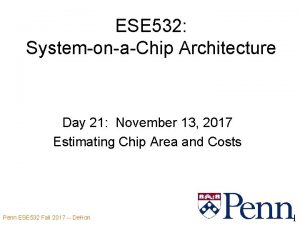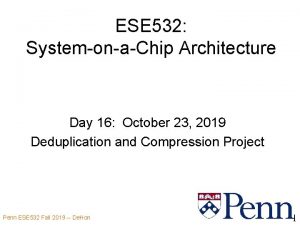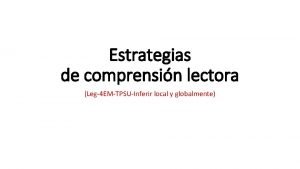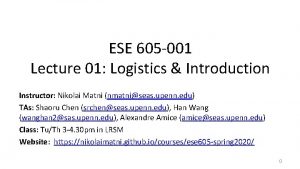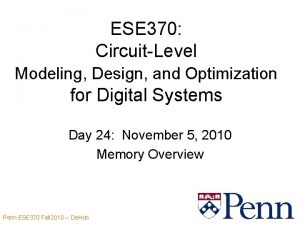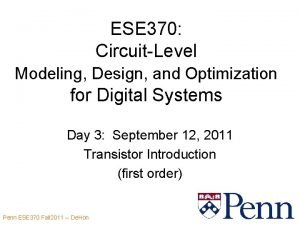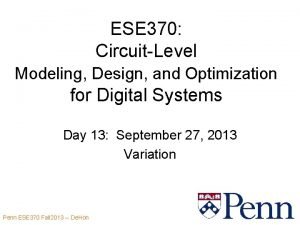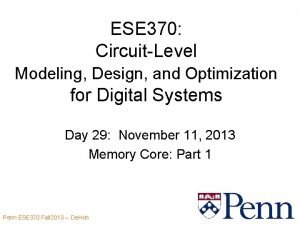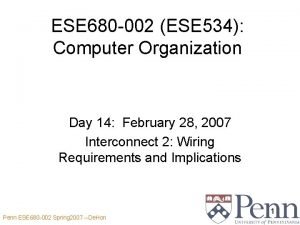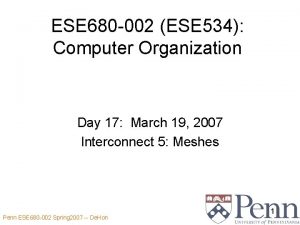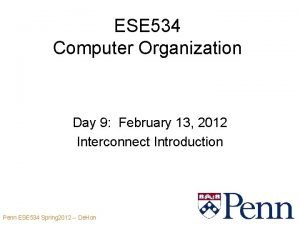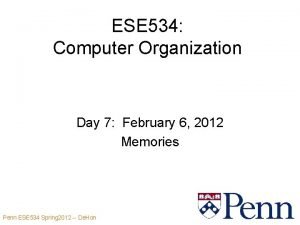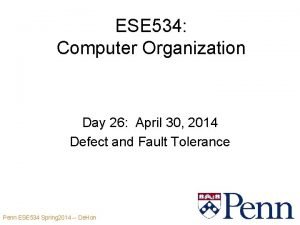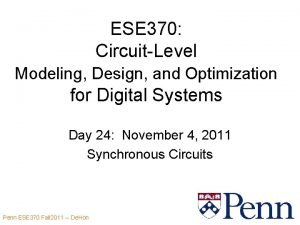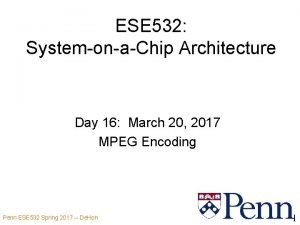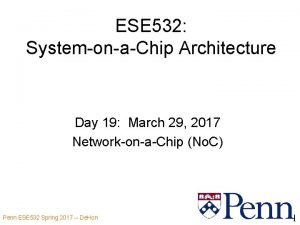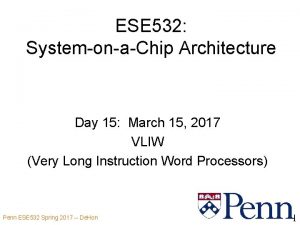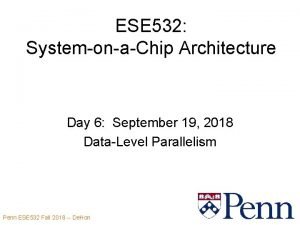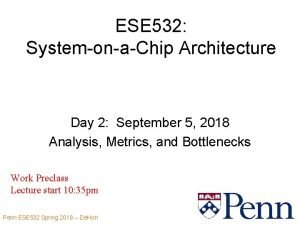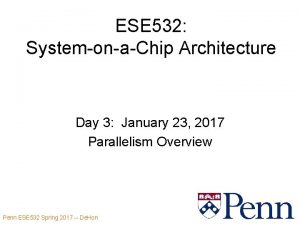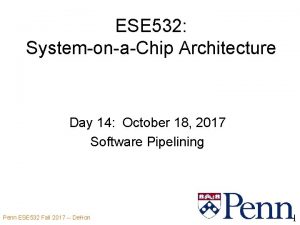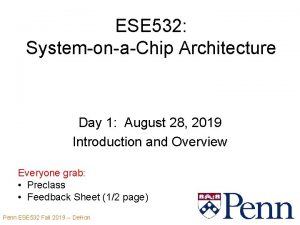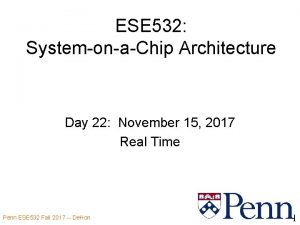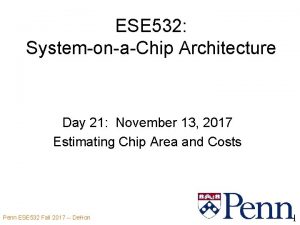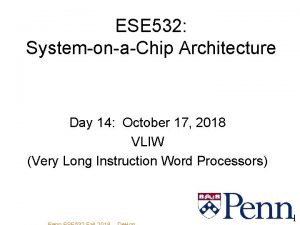ESE 532 SystemonaChip Architecture Day 14 March 13




















































- Slides: 52

ESE 532: System-on-a-Chip Architecture Day 14: March 13, 2017 Design Space Exploration Penn ESE 532 Spring 2017 -- De. Hon 1

Today • Midterm • Design-Space Exploration Penn ESE 532 Spring 2017 -- De. Hon 2

Message • The universe of possible implementations (design space) is large – Many dimensions to explore • Formulate carefully • Approach systematically • Use modeling along the way for guidance Penn ESE 532 Spring 2017 -- De. Hon 3

Midterm Penn ESE 532 Spring 2017 -- De. Hon 4

Mea Culpa • Too long – Too time constrained Penn ESE 532 Spring 2017 -- De. Hon 5

Mismatch? • What I think I’m teaching • What you think you are learning • Midterm focused on performance modeling Penn ESE 532 Spring 2017 -- De. Hon 6

Agree? • How to design/select/map to So. C to reduce Energy/Area/Delay? Penn ESE 532 Spring 2017 -- De. Hon 7

Day 1 Outcomes • Design, optimize, and program a modern System-on-a-Chip. • Analyze, identify bottlenecks, design-space • Decompose into parallel components • Characterize and develop real-time solutions • Implement both hardware and software solutions • Formulate hardware/software tradeoffs, and perform hardware/software codesign Penn ESE 532 Spring 2017 -- De. Hon 8

Day 1 Outcomes • Understand the system on a chip from gates to application software, including: – on-chip memories and communication networks, I/O interfacing, RTL design of accelerators, processors, firmware and OS/infrastructure software. • Understand estimate key design metrics and requirements including: – area, latency, throughput, energy, power, predictability, and reliability. Penn ESE 532 Spring 2017 -- De. Hon 9

Agree? • How to design/select/map to So. C to reduce Energy/Area/Delay? – Haven’t touched Area/Energy much, yet, so initial focus on Delay, Performance Penn ESE 532 Spring 2017 -- De. Hon 10

Reduce Delay • What can we do to reduce delay? • How know when we succeed? – Compile and run – How know what’s wrong and how to fix if we don’t get a speedup? • Need to be able to model, estimate, and reason about performance. Penn ESE 532 Spring 2017 -- De. Hon 11

Model to Select Design • Homework shows you that implementing a design is expensive • Goal: have a model to drive you to select good implementations to try Penn ESE 532 Spring 2017 -- De. Hon 12

Model to Understand • If not get the performance you expect, what went wrong? – Need an expectation – Need to drill down into components • Model expectations wrong? – Which part? – Refine? • Something went wrong in implementations? – What? – How fix to match model? Penn ESE 532 Spring 2017 -- De. Hon 13

Model to Understand • If not get the performance you expect, what went wrong? • Very Powerful • Not match something I need to understand – Bugs in implementation, understanding • Does match Tells me – where to look – what to try to fix – when to give up (on a particular approach) Penn ESE 532 Spring 2017 -- De. Hon 14

Expect • Kinds of analysis on the exam underlies all design exploration and experiments Penn ESE 532 Spring 2017 -- De. Hon 15

Day 2 Message for Day • Identify the Bottleneck – May be in compute, I/O, memory, data movement • Focus and reduce/remove bottleneck – More efficient use of resources – More resources • Repeat Penn ESE 532 Spring 2017 -- De. Hon 16

Second Half • How to design/select/map to So. C to reduce Energy/Area/Delay • Spend some more time understanding – Area • Started as we look at accelerators • …worry about fit in fixed array • Cost for custom design – Energy Penn ESE 532 Spring 2017 -- De. Hon 17

Design-Space Exploration Generic Penn ESE 532 Spring 2017 -- De. Hon 18

Design Space • Have many choices for implementation – Alternatives to try – Parameters to tune – Mapping options • Our freedom to impact implementation costs – Area, delay, energy Penn ESE 532 Spring 2017 -- De. Hon 19

Design Space • Ideally – Each choice orthogonal axis in highdimensional space – Want to understand points in space – Find one that bests meets constraints and goals • Practice – Seldom completely orthogonal – Requires cleverness to identify dimensions – Messy, cannot fully explore – But…can understand, priorities, guide Penn ESE 532 Spring 2017 -- De. Hon 20

Preclass 1 • What choices (design-space axes) can we explore in mapping a task to an So. C? • What showed up in homework so far? Penn ESE 532 Spring 2017 -- De. Hon 21

From Homework? • • • Types of parallelism Mapping to different fabrics / hardware How manage memory, move data Levels of parallelism Pipelining, unrolling, II Penn ESE 532 Spring 2017 -- De. Hon 22

Design-Space Choices • • • Type of parallelism How decompose / organize parallelism Area-time points (level exploited) What resources we provision for what parts of computation Where to map tasks How schedule/order computations How synchronize tasks How represent data Where place data; how manage and move What precision use in computations Penn ESE 532 Spring 2017 -- De. Hon 23

Generalize Continuum • Encourage to think about parameters (axes) that capture continuum to explore • Start from an idea – Maybe can compute with 8 b values – Maybe can put dist computation on FPGA fabric – Move data in 1 KB chunks • Identify general knob – Tune intermediate bits for computation – How much of computation go on FPGA fabric – What is optimal data transfer size? Penn ESE 532 Spring 2017 -- De. Hon 24

Finding Optima • Kapre, FPL 2009 Penn ESE 532 Spring 2017 -- De. Hon • Kadric, TRETS 2016 25

Design Space Explore • Think systematically about how might map the application • Avoid overlooking options • Understand tradeoffs • Large design space more opportunities to find good solutions Reduce bottlenecks Penn ESE 532 Spring 2017 -- De. Hon 26

Elaborate Design Space • Refine design space as you go • Ideally identify up front • Practice bottlenecks and challenges – will suggest new options / dimensions • If not initially expect memory bandwidth to be a bottleneck… • Some options only make sense in particular sub-spaces – Bitwidth optimization not a big issue on the 64 b processor • More interesting on vector, FPGA Penn ESE 532 Spring 2017 -- De. Hon 27

Tools • Sometimes tools will directly help you explore design space – What SDSo. C/Vivado HLS support? • Often they will not – What might you want that does not support? Penn ESE 532 Spring 2017 -- De. Hon 28

Tools • Sometimes tools will directly help you explore design space – Unrolling, pipelining, II – Some choices for data movement – Some loop transforms – Granularity to place on FPGA • Often they will not – Need to reshape functions and loops – Data representations and sizes Penn ESE 532 Spring 2017 -- De. Hon 29

Design-Space Exploration Example FFT Penn ESE 532 Spring 2017 -- De. Hon 30

Fourier Transform • Identify spectral components • Convert between Time-domain to Frequency-domain – E. g. tones from data samples – Central to audio coding – e. g. MP 3 audio Penn ESE 532 Spring 2017 -- De. Hon 31

Fast-Fourier Transform (FFT) • Efficient way to compute FT • O(N*log(N)) computation Penn ESE 532 Spring 2017 -- De. Hon 32

FFT • Large space of FFTs • Radix-2 FFT Butterfly Penn ESE 532 Spring 2017 -- De. Hon 33

Basic FFT Butterfly • Y 0=X 0+W(stage, butterfly)*X 1 • Y 1=X 0 -W(stage, butterfly)*X 1 • Common sub expression, compute once: W(stage, butterfly)*X 1 X 0 Y 0 X 1 Y 1 Penn ESE 532 Spring 2017 -- De. Hon 34

Preclass 2 • What parallelism options exist? – Single FFT – Sequence of FFTs Penn ESE 532 Spring 2017 -- De. Hon 35

FFT Parallelism • • Spatial Pipeline Streaming By column – Choose how many Butterflies to serialize on a PE • By subgraph • Pipeline subgraphs Penn ESE 532 Spring 2017 -- De. Hon 36

Streaming FFT Penn ESE 532 Spring 2017 -- De. Hon 37

Common Subgraphs Penn ESE 532 Spring 2017 -- De. Hon 38

Preclass 3 • How large of a spatial FFT can implement with 220 multipliers? Penn ESE 532 Spring 2017 -- De. Hon 39

Bit Serial • Could compute the add/multiply bit serially – One full adder per adder – W full adders per multiply – 50, 000 LUTs • ~= 2500 bit-serial butterflies for W=16? – Maybe 512 -point FFT? • Another dimension: – How much serialize word-wide operators Penn ESE 532 Spring 2017 -- De. Hon 40

Accelerator Building Blocks • What might we use as primitive, FFTspecific building blocks? Penn ESE 532 Spring 2017 -- De. Hon 41

Processor Mapping • How map butterfly operations to processors? – Implications for communications? Penn ESE 532 Spring 2017 -- De. Hon 42

Preclass 4 a • How large local memory to communicate from stage to stage? Penn ESE 532 Spring 2017 -- De. Hon 43

Preclass 4 b • How change evaluation order to reduce local storage memory? Penn ESE 532 Spring 2017 -- De. Hon 44

Communication • How implement the data shuffle between processors or accelerators? – Memories / interconnect ? – How serial / parallel ? – Network? Penn ESE 532 Spring 2017 -- De. Hon 45

Data Precision • Input data from A/D likely 12 b • Output data, may only want 16 b • What should internal precision and representation be? Penn ESE 532 Spring 2017 -- De. Hon 46

Number Representation • Floating-Point – IEEE standard single (32 b), double (64 b) • With mantissa and exponent • …half, quad …. • Fixed-Point – Select total bits and fraction • E. g. 16. 8 (16 total bits, 8 of which are fraction) – Represent 1/256 to 256 -1/256 Penn ESE 532 Spring 2017 -- De. Hon 47

Heterogeneous Precision • May not be same in every stage – W factors less than 1 – Non-fraction grows at most 1 b per stage Penn ESE 532 Spring 2017 -- De. Hon 48

W/Twiddle factors • Precompute and store in arrays • Compute as needed – How? sin/cos hardware? CORDIC? Polynominal approximation? • Specialize into computation – Many evaluate to 0, ± 1, ±½, …. Penn ESE 532 Spring 2017 -- De. Hon 49

FFT (partial) Design Space • Parallelism • Decompose • Size/granularity of accelerator – Area-time • • Sequence/share Communicate Representation/precisions Twiddle Penn ESE 532 Spring 2017 -- De. Hon 50

Big Ideas: • Large design space for implementations • Worth elaborating and formulating systematically – Make sure don’t miss opportunities • Think about continuum for design axes • Model effects for guidance and understanding Penn ESE 532 Spring 2017 -- De. Hon 51

Admin • HW 7 out due Friday – Individual • Working on getting Project ready Penn ESE 532 Spring 2017 -- De. Hon 52
 Ese 532
Ese 532 Ese 532
Ese 532 Ese 532
Ese 532 Ese 532
Ese 532 Ese 532
Ese 532 Ese 532
Ese 532 Ese 532
Ese 532 Ese 532
Ese 532 Day 1 day 2 day 3 day 4
Day 1 day 2 day 3 day 4 March march dabrowski
March march dabrowski Day 1 day 2 day 817
Day 1 day 2 day 817 Astronomy picture of the day march 29 2006
Astronomy picture of the day march 29 2006 March 23 world meteorological day
March 23 world meteorological day Decimal to octal exercises
Decimal to octal exercises Gdropbox
Gdropbox He leadeth me song
He leadeth me song Schoolmax gradebook
Schoolmax gradebook Oceans apart day after day
Oceans apart day after day Day to day maintenance
Day to day maintenance Physical science chapter 6 review answers
Physical science chapter 6 review answers Tomorrow i dont know
Tomorrow i dont know Romeo and juliet day timeline
Romeo and juliet day timeline Growing day by day
Growing day by day Observation of seed germination day by day
Observation of seed germination day by day Conclusion of seeds
Conclusion of seeds Geotropism
Geotropism I live for jesus day after day
I live for jesus day after day Rising he justified freely forever
Rising he justified freely forever Day one day one noodle ss2
Day one day one noodle ss2 Dayone dayone ss2
Dayone dayone ss2 Tekste argumentuese per mjedisin
Tekste argumentuese per mjedisin Sjellja konsumatore
Sjellja konsumatore Cenimi i jetes private
Cenimi i jetes private Ese teatri dhe mesazhi
Ese teatri dhe mesazhi Pasojat e luftes se dyte boterore
Pasojat e luftes se dyte boterore Ferri jane te tjeret ese
Ferri jane te tjeret ese Korn ese viejo nuevo metal
Korn ese viejo nuevo metal Ese 605 upenn
Ese 605 upenn Ese 370
Ese 370 Ese 370
Ese 370 Ese 370
Ese 370 Ese 370
Ese 370 Hay nos vidrios significado
Hay nos vidrios significado Lidershipi ese
Lidershipi ese Currency exchange rate definition
Currency exchange rate definition Ese
Ese Project management notes for ese
Project management notes for ese Ese
Ese Ese
Ese Ese
Ese Ese
Ese Nasa space shuttle
Nasa space shuttle Ese 370
Ese 370







